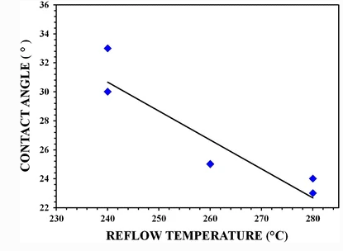What Should We Know about Solder Paste Wettability?
What should We Know about Solder Paste Wettability?
Solder paste is commonly used in the semiconductor packaging to connect chips and pads. Through printing, dispensing, and other processes, solder paste can become the connection medium between copper pads and chips. The solder paste melts during reflow soldering and solidifies into solder joints with uniform size, which achieves electrical interconnection. So what are the mechanisms of solder paste soldering? To understand it, you should have a basic understanding of wettability. Wettability is one of the key factors determining the soldering effect.
Excellent wettability can be understood as the fact that the solder paste can diffuse along the surface of the pads and metallurgically connect with the copper pads to generate specific intermetallic compounds. The way to judge wettability is to look at the angle formed between the solder paste and the copper pads. Generally, an contact angle greater than 90° is defined as poor wettability, which means the surface tension is large. If the angle is less than 90°, the solder wettability is acceptable. The figure below shows the soldering effect of SAC305 with excellent wettability.
Solder paste definition and use:
What is solder paste? Solder paste is composed of tin-based alloy powder (generally, powder with a particle size of 30~50 um is used, and ultra-fine solder paste is used with spherical powder with a particle size of 1~15 um), solder flux, and some additives. The solder paste is a stable mixture with a certain viscosity and good thixotropy. The solder paste can initially adhere electronic components to a given position at room temperature. After heating, the solvent and additives are volatilized, the tin powder melts, and the soldered parts are connected to the pads. After cooling, permanently connected solder joints are formed.
Solder paste composition and characteristics:
Table 1 shows the main components and functions of the solder paste. Table 2 reveals the mass and volume ratio of the solder alloy powder and flux in the solder paste.

Figure 1. SAC305 wetting process.
Since most pads are made of copper, they are susceptible to oxidation to generate an oxide layer. The tension between the surface of the solder paste particles and the oxide layer is very large, inhibiting the metallurgical reaction between the solder paste and the pads. Flux is an ingredient that provides wettability to solder paste. The active agent in the flux can react with the oxide layer and reduce the copper oxide to elemental copper. As a result, the surface tension at the connection between the solder paste and the pads is reduced. In addition, impurities on the surface of the copper pads will affect the solder paste's wettability, which is required to be removed in advance before packaging.
Solder alloy powder is affected by oxidation. Solder powder with small particle size oxidizes much faster than large particle size because of a larger surface area, making it more likely to react with oxygen to form an oxide film. Therefore, the alloy solder powder needs to be stored in a vacuum after the production is completed to avoid prolonged contact with the air.
The roughness of the substrate also affects the solder paste's solderability. Bhat et al. (2014) conducted a series of experiments and found that increasing the surface roughness of the copper pads improves the wettability of SnAg3.8Cu0.7 solder paste (Table 1). Additionally, the increased reflow temperature improves the wettability of the solder paste (Figure 2).
Table1.Copper pad surface roughness vs. solder paste wettability (Bhat et al. , 2014).


Figure 2. Contact angle between SAC387 on rough copper surface at different temperatures (Bhat et al., 2014).
Conclusion
Solder paste wettability is related to many factors, such as alloy particle oxidation degree, pad surface impurities, pad roughness, temperature, etc. Various factors that potentially affect wettability should be considered when designing flux formulations. Besides, extensive testing is required to confirm proper flux and operating parameters.
Fitech is committed to producing solder paste products with excellent wettability and soldering effect. Fitech can provide flux preparation and solder paste testing services based on customer needs. Welcome to consult.
Reference
Bhat, K.N., Prabhu, K.N. & Satyanarayan (2014), “Effect of reflow temperature and substrate roughness on wettability, IMC growth and shear strength of SAC387/Cu bonds”, Journal of Materials Science: Materials in Electronics, vol.25, pp.864-872.


















 Back to list
Back to list



